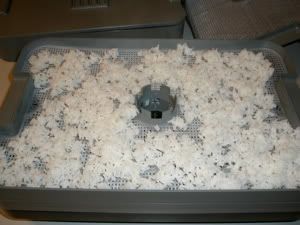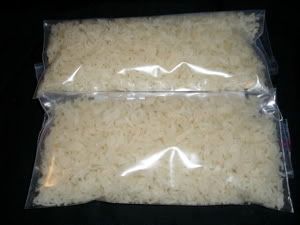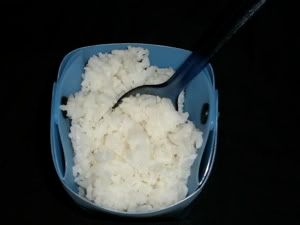Topic
DIY Instant Rice
Forum Posting
A Membership is required to post in the forums. Login or become a member to post in the member forums!
Home › Forums › General Forums › Food, Hydration, and Nutrition › DIY Instant Rice
- This topic is empty.
-
AuthorPosts
-
Dec 17, 2007 at 7:49 am #1226331
Commercial instant rice is easy to use, cheap and can be found almost everywhere. So what does it lack though?
Simply a deep taste and as well the texture that good quality rice has. Sadly with commercial instant rice you do have a major trade off. In burritos or used in soups on the trail it isn't so noticeable. But if your rice is the focal point it can come up very lacking.
Drying your own rice can open up a vast array of choice from Jasmine, sticky rices, brown, black, red and even wild rice. If you can buy the rice at the store you can dry it up! Considering you can find only white and a not-so-great brown rice in the majority of grocery stores, this allows you to have many more gourmet meals – and it only takes an hour or so total of your time to do it.
In most cases you will want to double whatever is the "serving size" on the rice package. That is often 1/4 cup dry rice. Figure 1/2 cup per serving of uncooked rice for trail appetites.
Cook your rice how you prefer making sure you don't add in oil or fat. For white rices I often bring 3 cups water to a boil and add in 1 1/2 cups rinsed rice, bring it back to a boil, stir well and put the lid on. Turn it down to low and let it simmer gently for 20 minutes. When done fluff the rice up well.
A great way to make brown rice was featured on Alton Brown's Good Eats show. Just leave out the fat (and it doesn't need all that salt either!)
Spread the cooked rice on prepared dehydrator trays – if you have fine mesh screen use them, if not line your trays with parchment paper. 1 1/2 cups uncooked rice takes up about 2 trays when cooked. Dry at 135-145*.
If you are drying using your kitchen oven spread the rice on cookie trays and set the oven to it's lowest setting. Put the trays in the oven and prop the door open a tiny bit with a wooden spoon.
Either way, check on your rice every hour and stir it breaking up any clumps. As the rice gets dry it will become very easy to get single grains.
The time depends on the humidity and if your dehydrator has a fan to help move off the moisture. Expect to take 4-12 hours (this isn't an exact science!)
Once the rice is brittle dry (no flexibility) turn off the dehydrator and let the rice cool to room temperature. Pack in freezer bags in serving sizes. While you can leave your rice in bulk storage, by splitting it up you will have ready to go bags. I ended with 3 bags of 3/4 cup cooked and dehydrated rice each. (This was based on 1/2 cup uncooked rice per serving)
For rehydrating use a ratio of 1:1. For 1 serving from above add 3/4 cup boiling water to the 3/4 cup dried rice. Stir well and put in a cozy for 15 minutes. Serve as usual!
The texture of the rice tastes almost the same as when it came out of the pan. Try drying your own and you most likely will never go back to using commercial instant rice.
Dec 17, 2007 at 2:32 pm #1412843I was really gettign sick of instant rice on the trail because it was bland. I will give this a try. Great article and detail!
Thank you
Dec 17, 2007 at 3:43 pm #1412853I, and friends of mine, have made alot of our own instant rice this way. We often cook it with a rediculous amount of olive oil aswell and then dehydrate it. While its a fair bit messier to make than just plain rice, once its in a snap lock its no hassle, and you get added calorific value of all that gooey fat.
Mind you, its been a couple of years since Ive made instant rice… I agree with the 4-12hrs-its time consuming, and because of the variability you dont want to leave the house.
Dec 17, 2007 at 3:49 pm #1412856The reason I mention no oil added is so that you get the longest storage life out of it (the fat is what goes rancid in storage). I carry a bottle of olive oil with me on trail :-)
Having said that, I still prefer to leave a tiny bit of fat in my hamburger when I dry it. Better flavor. I just use it up fast and store it in the freezer!Dec 17, 2007 at 8:32 pm #1412893Hi Sarah,
In Canberra Australia I have not been able to find instant rice and I would like to thankyou for your posting on how to make it.
Tony
PS I love your recipes from your web site.
Dec 17, 2007 at 10:31 pm #1412901Good timing Sarah. That last post about quinoa/rice just needed some directions. What is the weight of your 1/2 cup of rice after it's been cooked and dehydrated?
Santa is bringing me a dehydrator for X-Mas, so I'll find out all this for myself soon. Oh, I can't wait for something to distract me from building stoves.
-Michael
Dec 18, 2007 at 7:50 am #1412919Doh! Sorry about forgetting the weight…..
Ok, so the final serving size cooked and dehydrated comes out at 3 1/2 ounces. (That is 1/2 a cup raw rice cooked. It is 3/4 cup volume once dehydrated.)
Dec 18, 2007 at 4:51 pm #1412969I'm going to try the Sarah Rice technique. I've become an extra virgin olive oil fan. It's very good for you. My question: would you add the oil before pouring the boiled water in the freezer bag or mix it in after rehydrating the rice?
Dec 18, 2007 at 6:26 pm #1412977Last night, following Sarah's directions, I cooked 1 C of brown basmati rice, which weighed 5 oz., in my rice cooker and then spread it on a cookie sheet and put it in the oven set to "warm" for the rest of the evening. The wooden spoon to prop open the oven door was a bonus great idea! Twice I pulled out the cookie sheet and crumbled the drying rice. Around 10 pm I turned off the oven and left the cookie sheet in the oven until this evening. The rice was crispy dry.
The dried rice measured 10 oz. in volume, instead of the original 8 oz. as raw rice, and it still weighed 5 oz. I put 1/4 C in a ziploc bag and added 1/4 C boiling water and waited 15 minutes. It was still a bit crunchy, probably because brown rice in general takes more water to cook, so I added 2 TB water and microwaved it to finish cooking. Next time I'll know to use 1.5 times the amount of water to brown rice when I reconstitute it. The taste and texture were as good as freshly cooked.
Since I really like brown basmati rice, and I don't care much for instant white rice, this procedure has at last made it more likely that I'll make rice dishes on backpacking trips.
As for George's question about when to add the olive oil, it probably doesn't matter, but I will add it to the dry rice, just as I would add oil to raw rice when cooking it at home.
Another instant evergreen, Sarah!
Dec 18, 2007 at 6:51 pm #1412981Kathleen, I will do brown rice this week :-) I suspect that it does need more time in the cozy than white (instant commercial brown rice needs at least 15-20 minutes in a cozy) and you might be right on the water!
With the oil? I would add it in before you add the boiling water, the water spreads it around nicely!
Dec 19, 2007 at 9:31 am #1413051>>> The dried rice measured 10 oz. in volume, instead of the original 8 oz. as raw rice, and it still weighed 5 oz.
Just curious – is this because there is air space in the individual grains after the water is dried out?
Also, I will add the oil first. The oil will probably begin getting absorbed by the rice. Would this speed up or slow down the re-hydration process?
Dec 19, 2007 at 11:47 am #1413086George – in scientific terms, the dehydrated, cooked rice definitely looked chubbier than the raw rice. So that could account for the increase in volume. Probably some cell structure compromising going on there, but it's been decades since I studied biology.
I don't know whether rice absorbs oil or whether oil clogs rice, but the issue is probably moot, because I'm also adding water and heating it right away. I would guess the boiling water elbows its way past the viscous oil's clutches and plumps up the rice on its own terms. Now I've talked myself into being scared to eat the stuff….
Dec 19, 2007 at 4:18 pm #1413126i normally add olive oil to the rice whilst its cooking, but i do agree with the comments that it is more likely to be adsorbed rather than absorbed by the grains…it certainly seems like that with the finished product.
It might be easier to just add the olive oil later, in the field, to your meal. Might be less messy-Im not sure.
Dec 19, 2007 at 5:17 pm #1413140Does oil go bad? Particularly in high temps?
Dec 19, 2007 at 6:13 pm #1413149William, oil can go rancid in high temps, especially when present in food. A bottle of oil though has a good shelf life. Keep hands out of it, buy good brands and cycle through it – and keep it in a clean container.
The fat to worry about is in things like dried meat more than anything else.Dec 20, 2007 at 11:03 am #1413230Thanks Sarah. I'm running a multiday race in the Sahara this spring, and I'm trying to cut weight like crazy. Temps may get up to the 40s (Celsius). I'd love to take some oil as a calorie dense low volume food. My worry of course is that over 7 days the oil would spoil. Any experience in this type of situation?
Dec 20, 2007 at 4:30 pm #1413305If you really, really want to be sure it is fine go order a bunch of packets of olive oil from Minimus.biz :-) The oil is organic as well. Each packet is one serving. Myself I have never had my 4 ounce Lexan bottle of olive oil go bad in summer (if you think about it, I store the oil in my house as well, often in temps exceeding 80* in summer) for long periods.
But with it being a desert? I'd say get the packets!
Dec 21, 2007 at 8:40 am #1413378Excellent advice. Thanks a ton!
Jan 16, 2008 at 12:59 am #1416309William,
Having done a 5 week (bike) trip in temps like that, I feel pretty confident in saying that you'll have no problems with your oil spoiling. In fact considering your plans, I'd probably add the oil into the ziplock before you leave home (US). The rice will absorb it, minimising the risk of it leaking into the rest of your pack. This will also minimise prep time and complexity, which will be pretty important.
I would watch the GI of rice though, it's pretty high, and may not provide you with the fuel you need to make it through the day (or night)
Rod
-
AuthorPosts
- You must be logged in to reply to this topic.
Forum Posting
A Membership is required to post in the forums. Login or become a member to post in the member forums!
Our Community Posts are Moderated
Backpacking Light community posts are moderated and here to foster helpful and positive discussions about lightweight backpacking. Please be mindful of our values and boundaries and review our Community Guidelines prior to posting.
Get the Newsletter
Gear Research & Discovery Tools
- Browse our curated Gear Shop
- See the latest Gear Deals and Sales
- Our Recommendations
- Search for Gear on Sale with the Gear Finder
- Used Gear Swap
- Member Gear Reviews and BPL Gear Review Articles
- Browse by Gear Type or Brand.





